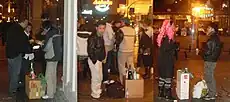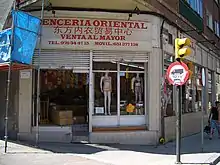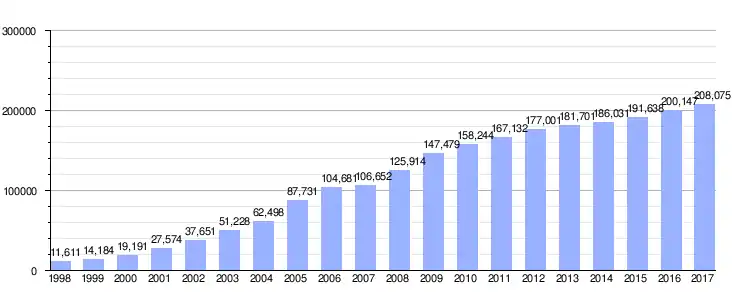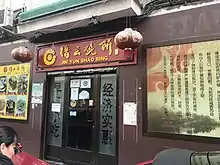Chinese people in Spain
Chinese people in Spain form the ninth-largest non-European Union foreign community in Spain.[3] As of 2009, official figures showed 145,425 Chinese citizens residing in Spain; however, this figure does not include people with origins in other Overseas Chinese communities, nor Spanish citizens of Chinese origin or descent.[2]
 Chinese people on the street in Madrid | |
| Total population | |
|---|---|
| 195,345 / 215,970 (2018)[n. 1] | |
| Regions with significant populations | |
| Madrid, Barcelona | |
| Languages | |
| Cantonese, Wenzhounese, Mandarin, Filipino, Cebuano, Spanish, Catalan | |
| Religion | |
| Related ethnic groups | |
| Han Chinese | |
History

The first recorded arrivals of Chinese people to Spain date from the late 16th century. Bernardino de Escalante in his Discurso de la navegación... (one of the first European books on China, published in 1577) says that among his sources of information were "Chinese themselves, who came to Spain" ("los mesmos naturales Chinas que an venido à España").[4] Juan González de Mendoza in his History of the great and mighty kingdom of China, wrote that in 1585 "three merchants of China" arrived in Mexico "and neuer staied till they came into Spaine and into other kingdomes further off."[5]
A legal case was brought before the Council of the Indies involving two Chinese men in Seville, one a freeman, Esteban Cabrera, and the other a slave, Diego Indio, against Juan de Morales, Diego's owner. Diego called on Esteban to give evidence as a witness on his behalf.[6][7] Diego recalled that he was taken as a slave by Francisco de Casteñeda from Mexico, to Nicaragua, then to Lima in Peru, then to Panama, and eventually to Spain via Lisbon, while he was still a boy.[8][9][10][11] Esteban testified that he knew Diego as a boy in Limpoa (Liampó, the Portuguese name of Ningbo, a Chinese city in Zhejiang), which he claimed to be part of the Spanish colonial indies.[12] This was a false claim since Liampo was not under Spanish rule, and it is speculated that Esteban and Diego lied about it in order to help Diego win his freedom, playing on the fact that the Spanish conducting the case were ignorant of Spain's Asian affairs. It worked in their favor and in July 1575 the Council issued a ruling siding with Diego.[13] Juana de Castañeda also testified on behalf of Diego, claiming that she knew Diego in Lima and she also married Esteban during the ordeal.[14][15] Juana was a native woman from Lima.[16][17][18] Juana was around 40 years old when she testified on behalf of Diego in 1572.[19] Another native woman from Panama, Isabel García also testified in favor of Diego, saying she knew him while he was in Panama.[20] Esteban's will dated 15 March 1599 left his property to his daughter Francisca de Altamirana and her husband Miguel de la Cruz who was a tailor and probably Chinese like Esteban.[21] A family of tailors was started by Esteban.[22] Tristán de la China was taken as a slave by the Portuguese,[23] while he was still a boy and in the 1520s was obtained by Cristobál de Haro in Lisbon, and taken to live in Seville and Valladolid. He was paid for his service as a translator on the 1525 Loaísa expedition,[24] during which he was still an adolescent.[25] The survivors, including Tristan, were shipwrecked for a decade until 1537 when they were returned to Lisbon by a Portuguese ship.[26] Records from 7 May 1618 show that Hernando de los Ríos Coronel was permitted to bring from the Philippines to Spain two Chinese slaves, named Cosme and Juan de Terrenate, who was married to a woman named Manuela.[27][28] Several Asians took advantage of laws requiring that the Spanish state pay for their return to their homeland after being trafficked to Spain illegally. A Chinese named Juan Castelindala Moreno petitioned to be sent home in 1632.[29]
Asian slaves who were shipped from the Spanish Philippines in the Manila-Acapulco galleons to Acapulco in New Spain (Mexico) were all called "Chino" which meant Chinese, although in reality they were of diverse origins, including Japanese, Malays, Javanese, Timorese, and people from Bengal, India, Ceylon, Makassar, Tidore, Terenate, and Chinese.[30][31][32][33]-[34] The people in this community of diverse Asians in Mexico were called "los indios chinos" by the Spanish.[35] Most of these slaves were male and were obtained from Portuguese slave traders who obtained them from Portuguese colonial possessions and outposts of the Estado da India, which included parts of India, Bengal, Malacca, Indonesia, Nagasaki in Japan, and Macau.[36][37] Some Spanish temporarily brought some of these Chino slaves to Spain itself from Mexico, where owning and showing off a Chino slave showed high class since Spanish aristocrats viewed their Chino slaves as fascinating trendy symbols of class. A Spanish woman, Doña María de Quesada y Figueroa,[38][39][40] in New Spain owned a China born Chinese man called Manuel who before being enslaved to her was taken from New Spain to be shown off in Seville until he was transferred to her ownership to be used by her as a slave by the woman's son Doctor D. Juan de Quesada in 1621.[41] Records of three Japanese slaves dating from the 16th century, named Gaspar Fernandes, Miguel and Ventura who ended up in Mexico showed that they were purchased by Portuguese slave traders in Japan, brought to Manila from where they were shipped to Mexico by their owner Perez.[42][43][44] Some of these Asian slaves were also brought to Lima in Peru, where there was a small community of Asians including Chinese, Japanese, and Malays.[45][46][47]
The first large wave of Chinese immigrants came to Spain in the 1920s and 1930s, working as itinerant peddlers. After World War II, they branched out into the restaurant industry, and later into textiles and trade.[48] However, the vast majority of Chinese residents in Spain started arriving in the country around the 1980s. According to Xu Songhua, president of the Association of Chinese in Spain (Asociación de Chinos en España), established in 1985, there are 13,000 Chinese-owned businesses in Spain, including 4,000 restaurants, 3,200 "dollar shops", 1,500 fruit shops, 600 wholesale warehouses, 80 Chinese groceries, 200 textile factories, and 120 photo processing shops.[49] Nowadays, Madrid and Barcelona are home to the largest Chinese communities of Spain. Unlike earlier waves of Chinese immigrants in other countries, over 80% of the Chinese in Spain come from Zhejiang's Qingtian County, with smaller numbers from Guangdong and Fujian. Others have come from Hong Kong, Macau, and Chinese communities of Southeast Asia, Latin America, and Europe.[49]
Demography
The age structure of Chinese in Spain is skewed very young; 2003 figures showed only 1.8% aged 65 or older, as compared to 7% of the population of the People's Republic of China and 17.5% of that of Spain,[50] while over 17% were under the age of 15.[49] As a result of the small proportion of elderly, combined with long working hours and the illegal status of some, Chinese are reported to use medical services at a far lower rate than other ethnic groups in Spain.[51]
Foreign population of Chinese citizenship in Spain
| Vertical bar chart of foreign population of Chinese nationality in Spain between 1998 and 2017 |
 |
| Population (1998-2017) Foreign population in Spain of Chinese nationality according to the Instituto Nacional de Estadística.[52]
|
Religion
A Taoist temple was opened in 2014 by the Chinese community of Barcelona, led by Taoist priest Liu Zemin, a 21st-generation descendant of poet, soldier and prophet Liu Bo Wen (1311-1375). The temple, located in the district of Sant Martí and inaugurated with the presence of the People's Republic of China consul Qu Chengwu, enshrines 28 deities of the province of China where most of the Chinese in Barcelona come from.[53][54]
Victimization
In September 2004, protests in Elche over cheap imported shoes from China undercutting local shoe markets resulted in the burning of a Chinese-owned shoe warehouse.[55] Crime is a problem in the Chinese community due to the triads, which are involved in human trafficking and extortion of Chinese business owners. However, the Triads have not established themselves as drug distributors due to competition from other groups.[56]
Notable people
- He Zhi Wen, world-ranked male table tennis player (Originally from Zhejiang, China)
- Shen Yanfei, world-ranked female table tennis player (Originally from Hebei, China)
References
- "Población (españoles/extranjeros) por País de Nacimiento, sexo y año". Instituto Nacional de Estadística. 2018. Archived from the original on 21 April 2017. Retrieved 26 January 2019.
- "Población extranjera por Nacionalidad, comunidades, Sexo y Año". Instituto Nacional de Estadística. 2018. Retrieved 26 January 2019.
- Nieto, G. (September 2003), "The Chinese in Spain", International Migration, Blackwell Publishing, 41 (3): 215–237, doi:10.1111/1468-2435.00247
-
- Escalante, Bernardino de (1577), Discurso de la navegación que los portugueses hazen a los reinos y provincias del oriente, y de la noticia que se tiene del reino de China (PDF), Sevilla, folio 100. (Modern transcription, with slight modification to the original orthography. Full text as a PDF file.)
- Juan González de Mendoza, The history of the great and mighty kingdom of China and the situation thereof. English translation by Robert Parke, 1588, in an 1853 reprint by Hakluyt Society. Page 95. Also quoted by Donald F. Lach. Modern annotations (as in the 1944 Spanish edition) note that this fact is absent in the first Spanish edition (Rome, 1585) but appears in the next Spanish edition (Madrid, 1586), meaning that Mendoza added a current fact to the new edition.
- Christina H Lee (2012). Western Visions of the Far East in a Transpacific Age, 1522–1657. Ashgate Publishing. p. 14. ISBN 978-1409483687. Retrieved 2 February 2014.
- Christina H. Lee, ed. (2016). Western Visions of the Far East in a Transpacific Age, 1522–1657. Routledge. p. 13 and 14. ISBN 978-1134759521. Retrieved 2016-05-23.
- Consejo Superior de Investigaciones Científicas (1984). José Jesús Hernández Palomo; Bibiano Torres Ramírez (eds.). Andalucia y America en el Siglo Xvi. p. 553. ISBN 8400056647. ISSN 0210-5802. Retrieved 2 February 2014.
{{cite book}}:|journal=ignored (help) - Fernando Iwasaki Cauti (2005). Extremo Oriente y el Perú en el siglo XVI. Vol. 12 of Colección Orientalia (illustrated ed.). Fondo Editorial PUCP. p. 293. ISBN 9972426718. Retrieved 2 February 2014.
- Christina H Lee (2012). Western Visions of the Far East in a Transpacific Age, 1522–1657. Ashgate Publishing. ISBN 978-1409483687. Retrieved 2 February 2014.
- Ignacio López-Calvo (2013). The Affinity of the Eye: Writing Nikkei in Peru. Fernando Iwasaki. University of Arizona Press. p. 134. ISBN 978-0816599875. Retrieved 2 February 2014.
- Christina H Lee (2012). Western Visions of the Far East in a Transpacific Age, 1522–1657. Ashgate Publishing, Ltd. ISBN 978-1409483687. Retrieved 2 February 2014.
- Christina H Lee (2012). Western Visions of the Far East in a Transpacific Age, 1522–1657. Ashgate Publishing. ISBN 978-1409483687. Retrieved 2 February 2014.
- Christina H Lee (2012). Western Visions of the Far East in a Transpacific Age, 1522–1657. Ashgate Publishing, Ltd. p. 14. ISBN 978-1409483687. Retrieved 2 February 2014.
- Studia, Issues 58-59. Centro de Estudos Históricos Ultramarinos. 2001. p. 24. Retrieved 2 February 2014.
{{cite book}}: CS1 maint: others (link) - Consejo Superior de Investigaciones Científicas (1984). José Jesús Hernández Palomo; Bibiano Torres Ramírez (eds.). Andalucia y America en el Siglo Xvi. p. 553. ISBN 8400056647. ISSN 0210-5802. Retrieved 2 February 2014.
{{cite book}}:|journal=ignored (help) - Bibiano Torres Ramírez, José Jesús Hernández Palomo, Escuela de Estudios Hispano-Americanos (Consejo Superior de Investigaciones Científicas), Huelva (Spain : Province). Excma. Diputación Provincial (1983). Bibiano Torres Ramírez; José Jesús Hernández Palomo (eds.). Andalucia y America en el Siglo XVI. Bibiano Torres Ramírez (illustrated ed.). Escuela de Estudios Hispano-Americanos, C.S.I.C. p. 553. ISBN 8400056647. Retrieved 2 February 2014.
{{cite book}}: CS1 maint: multiple names: authors list (link) - Fernando Iwasaki Cauti (2005). Extremo Oriente y el Perú en el siglo XVI. Vol. 12 (Colección Orientalia) (illustrated ed.). Fondo Editorial PUCP. p. 292. ISBN 9972426718. Retrieved 2 February 2014.
- Studia, Issues 58-59. Centro de Estudos Históricos Ultramarinos. 2001. p. 18. Retrieved 2 February 2014.
{{cite book}}: CS1 maint: others (link) - Studia, Issues 58-59. Centro de Estudos Históricos Ultramarinos. 2001. p. 22. Retrieved 2 February 2014.
{{cite book}}: CS1 maint: others (link) - Christina H Lee (2012). Western Visions of the Far East in a Transpacific Age, 1522–1657. Ashgate Publishing, Ltd. p. 14. ISBN 978-1409483687. Retrieved 2 February 2014.
- Christina H Lee (2012). Western Visions of the Far East in a Transpacific Age, 1522–1657. Ashgate Publishing, Ltd. p. 14. ISBN 978-1409483687. Retrieved 2 February 2014.
- Christina H Lee (2012). Western Visions of the Far East in a Transpacific Age, 1522–1657. Ashgate Publishing, Ltd. p. 13. ISBN 978-1409483687. Retrieved 2 February 2014.
- Christina H Lee (2012). Western Visions of the Far East in a Transpacific Age, 1522–1657. Ashgate Publishing, Ltd. ISBN 978-1409483687. Retrieved 2 February 2014.
- Christina H Lee (2012). Western Visions of the Far East in a Transpacific Age, 1522–1657. Ashgate Publishing, Ltd. ISBN 978-1409483687. Retrieved 2 February 2014.
- Christina H Lee (2012). Western Visions of the Far East in a Transpacific Age, 1522–1657. Ashgate Publishing, Ltd. ISBN 978-1409483687. Retrieved 2 February 2014.
- Christina H Lee (2012). Western Visions of the Far East in a Transpacific Age, 1522–1657. Ashgate Publishing, Ltd. ISBN 978-1409483687. Retrieved 2 February 2014.
- Studia, Issues 58-59. Centro de Estudos Históricos Ultramarinos. 2001. p. 29. Retrieved 2 February 2014.
{{cite book}}: CS1 maint: others (link) - Christina H Lee (2012). Western Visions of the Far East in a Transpacific Age, 1522–1657. Ashgate Publishing, Ltd. p. 14. ISBN 978-1409483687. Retrieved 2 February 2014.
- Walton Look Lai; Chee Beng Tan, eds. (2010). The Chinese in Latin America and the Caribbean (illustrated ed.). Brill. p. 12. ISBN 978-9004182134. Retrieved 2 February 2014.
- María Herrera-Sobek, ed. (2012). Celebrating Latino Folklore: An Encyclopedia of Cultural Traditions. Vol. 1 (illustrated ed.). ABC-CLIO. p. 59. ISBN 978-0313343391. Retrieved 2 February 2014.
- Wolfgang Binder, ed. (1993). Slavery in the Americas. Vol. 4 of Studien zur "Neuen Welt" (illustrated ed.). Königshausen & Neumann. p. 100. ISBN 3884797131. Retrieved 2 February 2014.
- Arnold J. Meagher (2008). The Coolie Trade: The Traffic in Chinese Laborers to Latin America 1847-1874. Arnold J. Meagher. p. 194. ISBN 978-1436309431. Retrieved 2 February 2014.
- James W. Russell (2009). Class and Race Formation in North America (illustrated, reprint ed.). University of Toronto Press. p. 27. ISBN 978-0802096784. Retrieved 2 February 2014.
- Claudia Paulina Machuca Chávez (Fall–Winter 2009). "El alcalde de los chinos en la provincia de Colima durante el siglo xvii" (PDF). Letras Históricas (in Spanish). Ciesas Occidente (1): 95–116. Archived from the original (PDF) on 2014-04-07.
- Déborah Oropeza Keresey (July–September 2011). "La Esclavitud Asiática en El Virreinato de La Nueva España, 1565-1673" (PDF). Historia Mexicana (in Spanish). El Colegio de México. LXI (1): 20–21.
- Déborah Oropeza (Autumn–Winter 2009). "Ideas centrales en torno a la esclavitud asiática en la Nueva España" (PDF). Historia Mexicana (in Spanish). Encuentro de Mexicanistas 2010 (La esclavitud asiática en el virreinato de la Nueva España, 1565-1673) (1): 2. Archived from the original (PDF) on 2014-04-07.
- Guillermo Lohmann Villena; Francisco de Solano (1993). Los Americanos en Las órdenes Nobiliarias. Vol. 7 (Colección Biblioteca de Historia de América) (illustrated ed.). Editorial CSIC - CSIC Press. p. 342. ISBN 8400073517. Retrieved 2 February 2014.
- Félix González de Leon (1844). Noticia artistica: histórica y curiosa de todos los edificios publicos, sagrados y profanos de esta muy noble, muy leal, muy heroica e invicta ciudad de Sevilla, y de muchas casas particulares, con todo lo que les sirve de adorno artístico, antiguedades, inscripciones y curiosidades que contienen. J. Hidalgo. p. 212. Retrieved 6 January 2014.
- Guillermo Lohmann Villena (1947). Santiago. Vol. 1 (Los americanos en las órdenes nobiliarias, Los americanos en las órdenes nobiliarias). Consejo Superior de Investigaciones Científícas, Instituto "Gonzalo Fernández de Oviedo". p. 342. Retrieved 6 January 2014.
- Walton Look Lai; Chee Beng Tan, eds. (2010). The Chinese in Latin America and the Caribbean (illustrated ed.). Brill. p. 13. ISBN 978-9004182134. Retrieved 2 February 2014.
- The Yomiuri Shimbun/Asia News Network (14 May 2013). "Japanese slaves taken to Mexico in 16th century". Asiaone News. Archived from the original on 18 February 2015. Retrieved 5 April 2014.
- Torres, Ida (14 May 2013). "Records show Japanese slaves crossed the Pacific to Mexico in 16th century". Japan Daily Press. Archived from the original on 31 January 2016. Retrieved 5 April 2014.
- Phro, Preston (15 May 2013). "To Mexico in Chains: The Tale of Three 16th Century Japanese Slaves". Rocket News 24.
- Leslie Bethell (1984). Leslie Bethell (ed.). The Cambridge History of Latin America. Vol. 2 (The Cambridge History of Latin America: Colonial Latin America. I-II) (illustrated, reprint ed.). Cambridge University Press. p. 21. ISBN 0521245168. Retrieved 2 February 2014.
- Ignacio López-Calvo (2013). The Affinity of the Eye: Writing Nikkei in Peru. Fernando Iwasaki. University of Arizona Press. p. 134. ISBN 978-0816599875. Retrieved 2 February 2014.
- Dirk Hoerder (2002). Cultures in Contact: World Migrations in the Second Millennium. Andrew Gordon, Alexander Keyssar, Daniel James. Duke University Press. p. 200. ISBN 0822384078. Retrieved 2 February 2014.
- Beltrán Antolín, Joaquín (1 February 2003), "Diáspora y comunidades asiáticas en españa (Asiatic diaspora and communities in Spain)", Revista electrónica de geografía y ciencias sociales, University of Barcelona, 7 (134), retrieved 8 December 2006
- Gómez, Luis (27 March 2005), "El poder chino en España (Chinese power in Spain)", El País, retrieved 8 December 2006
- Aranda, José (9 March 2005), "La mortalidad de los inmigrantes chinos en España (Mortality of Chinese immigrants in Spain)", Cinco Días.com, retrieved 7 December 2006
- Ly Pen, D. (July 2001), "Patologías prevalentes en pacientes de etnia china (Prevalent diseases of Chinese people in Spain)", Medifam, 11 (7): 34–44, retrieved 8 December 2006
- "Población extranjera por Nacionalidad, comunidades, Sexo y Año". Instituto Nacional de Estadística. Retrieved 2019-04-05.
- "S'ha inaugurat un temple taoista a Barcelona" Archived 2017-09-28 at the Wayback Machine. Generalitat de Catalunya, Departament de Governació, Administracions Públiques i Habitatge. 29/04/2014. Retrieved 06/05/2017.
- "Así funciona el primer templo taoísta de Barcelona". La Vanguardia, 23/04/2014. Retrieved 06/05/2017.
- Guo, Xiaohong (27 October 2004). "Spanish Arson a Warning to 'Made in China'". China.org.cn. Retrieved 7 December 2006.
- Resa Nestares, Carlos (7 December 2001), Transnational organised crime in Spain: Structural factors explaining its penetration, Autonomous University of Madrid, retrieved 7 December 2006
Further reading
- Nieto, Gladys (2003), "Overseas Chinese associations building up a national identity: specific cases in Spain", in Fernández-Stembridge, Leila (ed.), China Today: Economic Reforms, Social Cohesion, and Collective Identities, United Kingdom: Routledge, pp. 173–195, ISBN 0-415-31267-1
